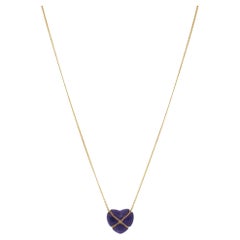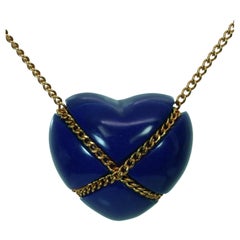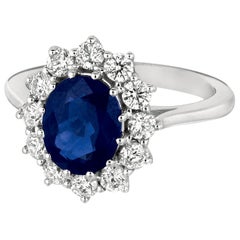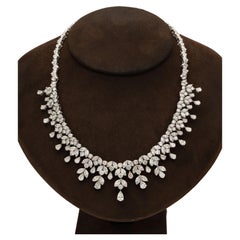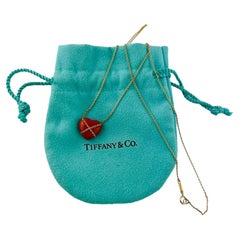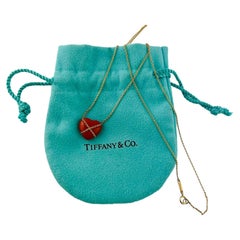Tiffany Cross Heart Necklace
1990s Pendant Necklaces
Amethyst, 18k Gold
1990s Pendant Necklaces
Lapis Lazuli, Yellow Gold
People Also Browsed
21st Century and Contemporary American Contemporary Engagement Rings
Diamond, Sapphire, White Gold
21st Century and Contemporary Drop Necklaces
Diamond, 18k Gold
Vintage 1980s Pendant Necklaces
White Diamond, Blue Sapphire, Gold, 18k Gold, Yellow Gold
Antique 18th Century Italian Victorian More Jewelry
18k Gold, Gold
2010s Turkish Modern Fashion Rings
Garnet, 14k Gold
21st Century and Contemporary Stud Earrings
Yellow Gold
21st Century and Contemporary American Contemporary Band Rings
Diamond, 18k Gold, Yellow Gold, Platinum
Vintage 1970s Pendant Necklaces
Yellow Gold
2010s French Pendant Necklaces
Yellow Gold
2010s Turkish Modern Stud Earrings
Ruby, 14k Gold
2010s Hong Kong Contemporary More Necklaces
Diamond, White Diamond, Emerald, Gold, 18k Gold, White Gold
2010s American Cocktail Rings
Pink Diamond, Platinum
Early 20th Century French Belle Époque More Jewelry
Diamond, Platinum
20th Century Belts
21st Century and Contemporary Pendant Necklaces
Yellow Gold
Antique Early 19th Century British George III Drop Earrings
Aquamarine, Gold, 18k Gold, Yellow Gold
Recent Sales
20th Century Pendant Necklaces
Coral, Yellow Gold
20th Century Pendant Necklaces
Coral, Yellow Gold
1990s Contemporary Drop Necklaces
Amethyst, Gold, 18k Gold, Yellow Gold
1990s Contemporary Drop Necklaces
Amethyst, Gold, 18k Gold, Yellow Gold
1990s Contemporary Pendant Necklaces
18k Gold, Yellow Gold, Gold
1990s Contemporary Drop Necklaces
Gold, 18k Gold, Yellow Gold
1990s Contemporary Pendant Necklaces
Lapis Lazuli, 18k Gold, Yellow Gold, Gold
1990s Contemporary Pendant Necklaces
Lapis Lazuli, Gold, 18k Gold, Yellow Gold
Mid-20th Century Unknown Modern Chain Necklaces
18k Gold, Yellow Gold
Late 20th Century Unknown Modern Pendant Necklaces
Amethyst, 18k Gold, Yellow Gold
Mid-20th Century Unknown Modern Chain Necklaces
18k Gold, Yellow Gold
Mid-20th Century Unknown Modern Chain Necklaces
Coral, 18k Gold, Yellow Gold
Mid-20th Century Unknown Modern Pendant Necklaces
Rock Crystal, 18k Gold, Yellow Gold
21st Century and Contemporary Pendant Necklaces
Diamond, Platinum
Vintage 1980s Pendant Necklaces
Lapis Lazuli, Yellow Gold
Late 20th Century American Modern Necklace Enhancers
14k Gold, Yellow Gold, Sterling Silver
21st Century and Contemporary Italian Contemporary Chain Necklaces
White Diamond, Sapphire, Blue Sapphire, Tsavorite, Diamond, Gold, 18k Go...
21st Century and Contemporary British Contemporary Pendant Necklaces
Diamond, White Diamond, Blue Diamond, 18k Gold
21st Century and Contemporary British Contemporary Pendant Necklaces
Diamond, White Diamond, Blue Diamond, 18k Gold
Tiffany & Co. for sale on 1stDibs
Tiffany & Co. is one of the most prominent purveyors of luxury goods in the United States, and has long been an important arbiter of style in the design of diamond engagement rings. A young Franklin Delano Roosevelt proposed to his future wife, Eleanor, with a Tiffany ring in 1904. Vanderbilts, Whitneys, Astors and members of the Russian imperial family all wore Tiffany & Co. jewels. And Jacqueline Kennedy Onassis preferred Tiffany china for state dinners at the White House.
Although synonymous with luxury today, the firm started out rather modestly. Charles Lewis Tiffany and John B. Young founded it in Connecticut as a “stationery and fancy goods emporium” in 1837, at a time when European imports still dominated the nascent American luxury market. In 1853, Charles Tiffany — who in 1845 had launched the company’s famed catalog, the Blue Book, and with it, the firm’s signature robin’s-egg blue, which he chose for the cover — shifted the focus to fine jewelry. In 1868, Tiffany & Co. gained international recognition when it became the first U.S. firm to win an award for excellence in silverware at the Exposition Universelle in Paris. From then on, it belonged to the pantheon of American luxury brands.
At the start of the Gilded Age, in 1870, Tiffany & Co. opened its flagship store, described as a "palace of jewels" by the New York Times, at 15 Union Square West in Manhattan. Throughout this period, its designs for silver tableware, ceremonial silver, flatware and jewelry were highly sought-after indicators of status and taste. They also won the firm numerous accolades, including the grand prize for silverware at the Paris Exposition of 1878. Among the firm’s glittering creations from this time are masterworks of Art Nouveau jewelry, such as this delicate aquamarine necklace and this lavish plique-à-jour peridot and gold necklace, both circa 1900.
When Charles Lewis Tiffany died, in 1902, his son Louis Comfort Tiffany became the firm’s design director. Under his leadership, the Tiffany silver studio was a de facto design school for apprentice silversmiths, who worked alongside head artisan Edward C. Moore. The firm produced distinctive objects inspired by Japanese art and design, North American plants and flowers, and Native American patterns and crafts, adding aesthetic diversity to Tiffany & Co.’s distinguished repertoire.
Tiffany is also closely associated with diamonds, even lending its name to one particularly rare and exceptional yellow stone. The firm bought the Tiffany diamond in its raw state from the Kimberley mines of South Africa in 1878. Cut to create a 128.54-carat gem with an unprecedented 82 facets, it is one of the most spectacular examples of a yellow diamond in the world. In a broader sense, Tiffany & Co. helped put diamonds on the map in 1886 by introducing the American marketplace to the solitaire diamond design, which is still among the most popular engagement-ring styles. The trademark Tiffany® Setting raises the stone above the band on six prongs, allowing its facets to catch the light. A lovely recent example is this circa-2000 platinum engagement ring. Displaying a different design and aesthetic (but equally chic) is this exquisite diamond and ruby ring from the 1930s.
Finding the Right pendant-necklaces for You
Whether you’re layering multiple jewelry pieces or opting for a single strand, vintage pendant necklaces are versatile accessories that can elevate your casual wear as easily as they can add a creative flourish to your formal attire.
The earliest jewelry was less about accessorizing than it was about wearers arming themselves with amulets. In Ancient Egypt, some amulets featured a loop so that they could be strung around one’s neck. While rubies have long been one of the few gemstones that can give diamonds a run for their money, members of some ancient civilizations valued the stones from the get-go, donning ruby pendants as well as other stones with the belief that these adornments would bring protection, healing powers or strength. Today, we still wear our charm bracelets and charm pendants around our necks for good luck.
Later, pendant necklaces, like most fine jewelry, were worn strictly by royalty or the upper class and conferred wealth and prestige. This changed over time, thankfully, as wearing jewelry became more widespread, a democratized means of personal expression.
During the 18th and 19th centuries, pendant necklaces evolved from their status as spiritual amulets, but the jewels still carried deep personal significance. Victorian pendants, in particular, were part of the “mourning jewelry” tradition. Wearers would embed their pendants with locks of hair from a deceased loved one as a way of grieving in the wake of a loss. In the case of cameo jewelry, some pendants were even decorated with miniature hand-carved portraits in a detailed raised relief. Today, portraiture is still a characteristic of many of the hand-carved pendant necklaces offered by Italian jewelry house Scala Gioielli.
Luxury fine jewelry brands such as Cartier, BVLGARI and David Yurman offer their own unique interpretations of the cherished accessory, embellishing platinum or gold pendant necklaces with diamonds, sapphires and other stones.
On 1stDibs, find an extraordinary range of vintage pendant necklaces and other necklaces today.
- 1stDibs ExpertAugust 17, 2021A Tiffany & Co. engagement ring can cost as little as $13,000 or as much as $500,000 depending on the center stone’s carat weight, the band material and whether or not there are any side stones. The smaller the stone, the cheaper the ring will be. Find engagement rings designed by Tiffany & Co. on 1stDibs.
